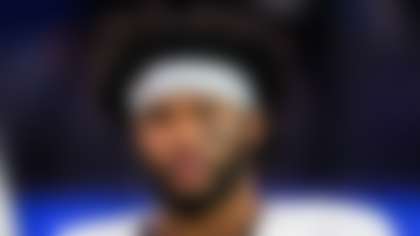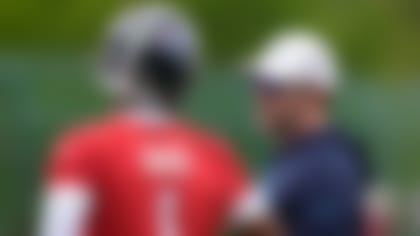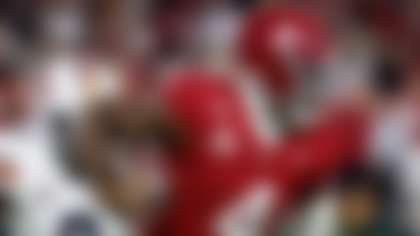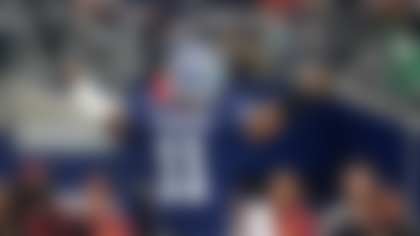Former NFL player and scout Bucky Brooks knows the ins and outs of this league, providing keen insight in his notebook. The topics of this edition include:
But first, a look into mounting concerns around the NFL's most recent No. 1 overall pick ...
What's wrong with Trevor Lawrence?
That is the question running rampant in the scouting community after watching the Jacksonville Jaguars QB's performance in the first 10 games of his rookie season.
The first overall pick of the 2021 NFL Draft is languishing near the bottom of the charts in completion percentage (58.4, 31st), pass yards per attempt (6.0, 33rd), touchdown-to-interception ratio (8:9, 30th) and passer rating (72.8, 31st) among the 34 players with at least 150 pass attempts this season, per Next Gen Stats. His 13 giveaways are tied for the third-most in the NFL, and he has gone three straight contests without throwing a touchdown pass or reaching 170 yards passing.
After being billed as a generational talent since early in his college career at Clemson, Lawrence's play for the Jaguars has led to questions about his talent, potential and long-term development.
However, before we get too carried away with our critiques, I believe we should keep his struggles in perspective. Don't overlook the fact that he is adjusting to the pro game while playing for a franchise that has produced only one winning season since 2008. Lawrence did not step into an organization with a winning pedigree or an established blueprint for developing a franchise quarterback. In addition, the team is being led by a longtime college coach who had no prior NFL experience. That is not a jab at Urban Meyer, but the rookie head coach is still adjusting to a game vastly different from the college football landscape that he dominated for the better part of two decades.
Lawrence has certainly flashed the A+ talent that made evaluators drool over his potential throughout a decorated Clemson career, but he has also made some poor throws and questionable decisions that have led to turnovers. Some of those struggles should be expected from an ultra-competitive quarterback attempting to put the team on his back before he is ready to take on the responsibility of being the ultimate leader and franchise player. If Lawrence remains patient while adjusting to the complexities of NFL defenses and the speed of defenders, he has more than enough talent to dominate at his position over the next decade.
The Jaguars will need to take some steps to help him maximize his potential, though, and that means upgrading his supporting cast. If you are a regular listener to the Move The Sticks podcast, you have heard my colleague Daniel Jeremiah and I discuss the importance of the three Ps -- protection, playmakers and play-callers -- to a young quarterback. The great teams prioritize improving in each of those areas to ensure the QB is comfortable and able to flourish without feeling the need to put the weight of the world on his shoulders.
When I review the game tape and look at the Jaguars' depth chart, I see a roster that isn't quite where it needs to be for Lawrence to perform at an all-star level. I anticipated some of these issues while studying the team throughout the preseason as the Jags' color analyst, but I thought the offensive line and running back James Robinson were good enough for Jacksonville to be able to rely on a blue-collar running game to alleviate some of the pressure on the quarterback. I was wrong. The team's running game is a middling unit, and a lack of offensive balance has forced Lawrence to throw against defenses waiting on the passing game. While this limits the overall effectiveness of play-action passes, the Jaguars still have not called nearly enough movement plays from under-center alignments (more on that in a little bit). And the inconsistent ground game has prevented the young quarterback from throwing on manageable downs.
Digging deeper into Lawrence's woes as a passer, I believe the lack of playmakers on the perimeter might be a bigger issue than the offensive line. The Jaguars do not have a top-50 receiver in the lineup. The lack of speed and play-making ability on the field makes it hard for the rookie to produce explosive plays in the passing game. The primary pass catchers are unable to separate from tight coverage down the field, and the small windows available to Lawrence remind me of tossing softballs into milk cans at the state fair. In other words, he has a tiny margin for error. He has to throw a perfect ball to get a completion or it will be batted away by defenders draped over his intended target.
Perhaps things would have been different if WR D.J. Chark had not suffered a broken ankle back in September, but Jacksonville needs multiple B+ (or better) pass catchers on the perimeter to help Lawrence find his rhythm as a passer. Just look at the playmakers the Bills have surrounded Josh Allen with (Stefon Diggs, Cole Beasley, Dawson Knox and Emmanuel Sanders) or the crew the Chargers have put together around Justin Herbert (Keenan Allen, Mike Williams, Austin Ekeler and Jared Cook). It's not a coincidence that those two young gunslingers are having success and leading winning teams.
The Jaguars should also examine the system the rookie is being asked to play in. As an RPO playmaker at Clemson, Lawrence threw a number of quick tosses and bubble screens off run-action to compile gaudy numbers as a pinpoint passer. Perhaps Meyer should consider baking some of those concepts into the Jaguars' playbook to help the 22-year-old build confidence by knocking down some layups that are created by the scheme.
The team also needs to better utilize Lawrence's athleticism by featuring more movement passes (bootlegs, sprint-outs and rollouts) to change the launch point of the passing game while also providing the rookie with easier throws away from the middle of the field. That suggestion is not a knock on Lawrence's diagnostic skills or his football intelligence; it's simply an easy way to add some high-percentage plays to a playbook that currently features too many throws with a high degree of difficulty. I am sure offensive coordinator Darrell Bevell is looking to do everything in his power to make the game easier for Lawrence, but more movement throws could help unlock the young passer's superpowers.
It remains to be seen if the Jaguars will make the necessary moves to help Lawrence flourish as a franchise quarterback, but the coaching staff and front office need to huddle up and find a way to get him going if they're going to contend for a playoff spot in the near future.
MICAH PARSONS: The DROY and DPOY?
It appears to be a foregone conclusion that Micah Parsons is going to walk away with the Defensive Rookie of the Year award, but the Cowboys phenom might also be the best defensive player in the league.
Perhaps I am caught up in the moment after watching Parsons put on a show against the Raiders on Thanksgiving Day. Dallas lost the game, but the jaw-dropping performance (five tackles, one sack, two tackles for loss and five quarterback hits) on a big stage enabled the football world to catch a glimpse of the unique combination skills that separates the rookie from others.
At 6-foot-3, 245 pounds with freakish athleticism and explosiveness, Parsons plays like a bull in a china shop. He relies on his instincts and superior physical tools to overwhelm opponents and few blockers have the capacity to neutralize him when he pulls the trigger after diagnosing the play. Whether it's reading the run and shooting gaps to corral the ball-carrier or blowing up "give-keep" reads against the read-option, Parsons is a destructive force against the run.
His disruptiveness as a run defender earns rave reviews, but it's Parsons' dominance as a part-time pass rusher that has truly elevated him to a level all his own this season. He shows exceptional first-step quickness and snap count anticipation blowing past blockers on the edges while utilizing moves that range from finesse to power maneuvers. Parsons shows the ability to win with a speed rush, hesitation moves (in-out, stutter steps) and bull rushes.
While he's not a full-time pass rusher, Parsons leads the Cowboys in sacks with nine (a franchise record for a rookie) and QB pressures (36), per Next Gen Stats. Those numbers are significant because they speak to his impact as a playmaker off the edge in a game that is all about the getting to the quarterback and defending the pass.
That's why I'm willing to out on a limb and tout Parsons as a leading Defensive Player of the Year candidate despite his inexperience. Sure, Lawrence Taylor is the only rookie to ever win the award -- and he was inducted into the Pro Football Hall of Fame as one of the most dominant defenders of the modern era -- but I believe No. 11 could revolutionize the game in a similar fashion as a hybrid defender with A-plus pass-rush skills.
While I am not quite ready to put Parsons in LT's category right now, the Cowboys standout has a chance to join the NFL legend's exclusive rookie DPOY club if he continues to terrorize opponents off the edge.
Is Justin Jefferson the NFL's new WR1?
The annual showdowns between the Green Bay Packers and Minnesota Vikings are always must-see TV due to the ultra-competitive nature of the NFC North rivals. But last Sunday's matchup also enabled the football world to see two of the league's best receivers square off in a head-to-head battle that might have changed how observers view the top five players at the position, particularly at the very top of the list.
Davante Adams has garnered plenty of backing as the NFL's top wideout in recent years, with a pair of 1,300-yard seasons in 2018 and 2020, as well as 41 touchdown receptions in his last 51 games. He is arguably the best route runner in the league. With an assortment of moves and impeccable timing, Adams is nearly impossible to shadow on the perimeter. As a sure-handed pass catcher with dynamic open-field running skills, he's the ultimate chain mover and scoring threat at the position with his impressive stat sheet reflecting his immense impact.
That said, Justin Jefferson is gaining ground on Adams as a second-year pro putting up spectacular numbers and jaw-dropping tape as the Vikings' lead receiver. In 24 starts, the 6-foot-1, 195-pounder has 11 100-yard games (tied for most since 2020 with Adams), thanks to a polished game that has caught the attention of players, coaches and scouts around the league.
"I see a six-year vet when I watch him play," Adams said of Jefferson prior to their Week 11 meeting. "He reminds me of ... I don't even know how to ... I haven't seen anybody come in in a while and play like the way that he's playing right now. He really strikes me as somebody that has it figured out, whatever that means. 'Cause I wasn't playing that fast in my first and second year.
"Last year, he already looked like he'd been playing for four years at that point, so he's kind of aging like a dog right now, and I mean in its purest form because he's a dog out there and I respect what he's doing and it's really fun to watch."
Jefferson was as good as advertised in the matchup, with an eight-catch, 169-yard effort that also included two scores in Minnesota's 34-31 win over Green Bay. The second-year pro could not be guarded on the perimeter despite facing a variety of schemes designed to force the quarterback to go elsewhere with the ball. Jefferson outworked and outmaneuvered the Packers' defense at every turn, and his steady production is exactly what is expected of a No. 1 receiver in the clutch. Adams, for his part, caught seven passes for 115 yards and two scores. Not too shabby.
Since the beginning of 2020, Jefferson has logged the most receptions of 15-plus yards while showing big-time play-making skills. He is a crafty route runner with a knack for winning at the line of scrimmage and at the top of the route, utilizing a variety of stutter-steps and hesitation moves. He creates space against tight coverage and his ability to get open against any and every tactic cements his status as a true WR1.
With Jefferson showing his immense talents in an impressive performance against the Packers and the NFL's reigning WR1 in Adams, it might be time to open up the polls and see if No. 18 deserves to sit on the throne as the top receiver in the game.
RAVENS: How to fix secondary struggles
I love the Baltimore Ravens' aggressive defensive approach, but I wonder if defensive coordinator Don "Wink" Martindale needs to scale back on his pressures with a young defensive backfield struggling in coverage.
It is hard to imagine Baltimore playing read-and-react defense after dominating opponents with blitz-heavy tactics over the past 20 years, but the flurry of big plays allowed by the unit this season has to force the wily defensive architect to re-evaluate as the team makes a playoff push down the stretch.
The Ravens rank 31st in pass defense (281.1 pass yards per game) due to their propensity to give up big plays through the air. The unit has surrendered 47 receptions of 20-plus yards (second-most in the NFL) while also allowing 11 receptions of at least 40 yards (tied for the most in the NFL). The aerial assault has resulted in quarterbacks averaging 8.1 yards per attempt (third-most) despite facing a barrage of blitzes and pressures from a variety of personnel packages expected to keep opponents guessing at the line of scrimmage.
While the heavy-pressure tactics have allowed the Ravens to neutralize the ground attack with the NFL's second-best run defense (88.6 yards per game), the feast-or-famine approach has not yielded the turnovers (only eight takeaways) or sacks (23) to offset the big plays surrendered on the perimeter.
If the Ravens were giving up big plays due to one-on-one wins by the opponent, I would not be as concerned about their decision to go after quarterbacks with blitzes from all over the field. However, it has been the mental mistakes and coverage busts that make me wonder if Martindale is doing too much with his personnel.
Remember, the secondary is missing a Pro Bowl-caliber corner with great instincts and ball skills, as Marcus Peters suffered a torn ACL just before the season kicked off. The unit is also without starting safety DeShon Elliott, who served as the traffic cop in the back end before his season-ending biceps/pectoral injury earlier this month. As a result, the Ravens have miscommunication issues and assignment errors due to a lack of experience and expertise within the scheme. In addition, the revolving door at cornerback and safety has led to inconsistent execution in key moments.
With that in mind, Martindale should consider scaling back on some of the exotic blitzes and calls to give his defensive backs a chance to understand exactly what they are doing on each assignment. While he does not need to reduce his blitz percentage, he could simplify his blitz calls to ensure every defender understands how he is expected to fit into the puzzle.
The Ravens must also emphasize situational awareness, particularly with their younger defenders, to remind them of the objectives of the play call at certain moments. With a greater understanding of the call, the defense should play with better awareness and focus on critical downs.
The final part of the makeover is on the players. The secondary must improve tackling and attention to detail. In a blitz-happy defense, the cornerbacks and safeties are frequently left on islands without a lot of help from underneath defenders. This makes it imperative for the cover men to make one-on-one tackles in space to ensure 5-yard completions do not turn into 15- and 20-yard gains. From their pursuit angles to their ability to wrap and squeeze receivers with the ball, Ravens defensive backs have to tighten up on the little things to keep their coverage woes from escalating into a problem that prevents a gritty team from making a run in the playoffs.
Follow Bucky Brooks on Twitter.












